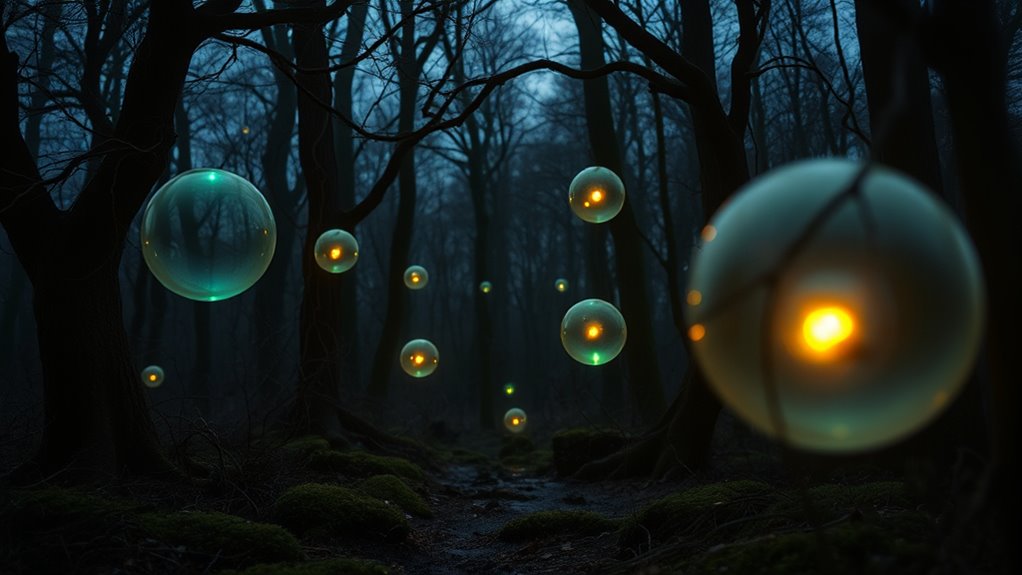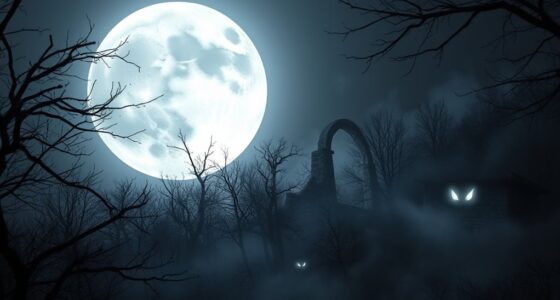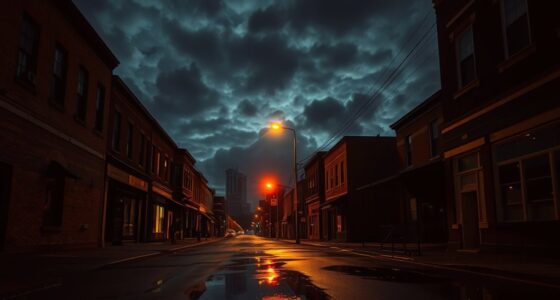Many believe orbs in photos are proof of spirits, but scientifically, they’re just camera artifacts caused by dust, pollen, insects, or reflections from water droplets near the lens. Modern cameras easily pick up these natural particles, especially with settings like flash or slow shutter speed. These orbs are illusions, not supernatural signs. If you want to understand why so many see ghosts in images, explore the explanations behind these common phenomena.
Key Takeaways
- Orbs are often mistaken for spirits but are typically camera artifacts caused by environmental particles and lighting.
- Scientific analysis shows most orbs result from dust, pollen, insects, or reflections, not supernatural activity.
- Modern camera settings and technology can create or enhance orb appearances, reinforcing natural explanations.
- Critical thinking and understanding imaging artifacts help distinguish between genuine paranormal evidence and natural phenomena.
- The myth linking orbs to spirits lacks consistent scientific evidence, and rational analysis demystifies their true origins.

Many people believe that orbs captured in photographs and videos are clear evidence of spirits, but the truth is more complicated. When you look at paranormal photography, these glowing or circular shapes often seem to suggest supernatural activity. However, experts in scientific skepticism argue that most orbs are simply artifacts created by camera technology, environmental factors, or lighting conditions. This discrepancy between perception and reality fuels the myth that orbs are direct proof of spirits, but understanding the science behind these images reveals a different story.
In reality, orbs are usually caused by dust, pollen, insects, or water droplets close to the camera lens. When a camera flashes or uses a bright light source, these particles reflect light back into the lens, creating the bright, circular shapes you see. Many of these images lack any depth or context that would suggest a supernatural origin. Instead, they result from natural phenomena that are easily explained with basic scientific principles. This is where scientific skepticism plays a *vital* role: it encourages you to question initial impressions and seek logical explanations before jumping to paranormal conclusions.
Furthermore, the technology behind modern cameras and smartphones makes capturing such artifacts commonplace. Small particles near the lens are often overlooked but can easily produce orbs in photographs. These are not intentionally manipulated images but simple optical effects. Sometimes, camera settings like a slow shutter speed or high ISO can intensify the appearance of these orbs, making them look more mysterious than they actually are. When you understand these technical details, it becomes clear that many supposed “spirit orbs” are nothing more than photographic illusions.
Additionally, understanding imaging artifacts helps clarify how these effects occur and why they are often mistaken for supernatural phenomena. While paranormal enthusiasts may see orbs as proof of spirits, scientific skepticism emphasizes that extraordinary claims require extraordinary evidence. Most orb images lack consistent features that would definitively link them to supernatural entities. Instead, they fit neatly into natural explanations rooted in environmental and technological factors. This doesn’t mean all orb images are invalid, but it does mean you should approach them with caution and critical thinking.
In the end, the allure of spirits captured in orbs is powerful, but the scientific perspective shows that these images are more often natural phenomena than supernatural messages. By understanding how camera technology and environmental factors create these effects, you can separate myth from reality. Recognizing the role of scientific skepticism helps you avoid jumping to conclusions based on ambiguous images and encourages a more rational approach to paranormal photography.
Frequently Asked Questions
Can Orbs Be Captured With Standard Smartphone Cameras?
Yes, you can capture orbs with your smartphone camera, but what you’re seeing might be camera artifacts rather than spirits. These orbs often appear due to dust, moisture, or lens reflections. Sometimes, photo editing can enhance or create the illusion of orbs, making them seem more mysterious. To improve your chances, clean your lens, use low light, and avoid flash, which can increase reflections and false positives.
Are There Scientific Explanations for Orb Phenomena?
Yes, there are scientific explanations for orb phenomena. You might notice camera artifacts or photographic illusions, especially when using flash or low-light settings. These can create orbs that aren’t related to spirits but are simply results of dust, moisture, or lens reflections. Understanding that these visual effects are caused by technical factors helps you see that orbs aren’t necessarily proof of paranormal activity.
How Do Different Lighting Conditions Affect Orb Appearances?
Lighting conditions lead to lively, layered orb appearances. When you change your lighting, you alter how light reflection happens, making orbs look different. Bright lights can cause camera artifacts, creating glowing orbs, while dim settings might hide them altogether. Shadows and uneven lighting add to the confusion, making orbs seem more mysterious. So, your lighting choices directly influence whether orbs appear vivid, vague, or vanish entirely in your photos.
What Cultural Beliefs Associate Orbs With Spirits Worldwide?
You’ll find that many cultures see orbs as symbols of spiritual connections, representing the presence of spirits or ancestors. For example, in Asian traditions, orbs symbolize divine energy or protection, while in Western folklore, they often signify ghostly spirits. These cultural symbols highlight how orbs serve as powerful visual cues of spiritual symbolism, reinforcing the idea that they are more than just optical phenomena—they embody deep spiritual connections across the world.
Can Professional Paranormal Investigators Distinguish Real Orbs From Fake?
You can’t just spot a floating ball and call it a spirit; professional paranormal investigators use specialized techniques and investigator tools to tell real orbs from fake. They analyze light reflections, camera settings, and environmental factors, like dust or moisture, which can mimic spirits. By applying these paranormal techniques, they peel back illusions, revealing whether those glowing orbs are authentic signs or just tricks of the light.
Conclusion
You might want to believe orbs are proof of spirits, but the truth is more complex. While they can look mysterious and even spiritual, science shows they’re often just dust, moisture, or camera artifacts. Keep an open mind, but also question what you see. Sometimes, seeking the truth means looking beyond illusions and understanding the real causes. Remember, belief is powerful, but evidence is even more so in uncovering reality.









